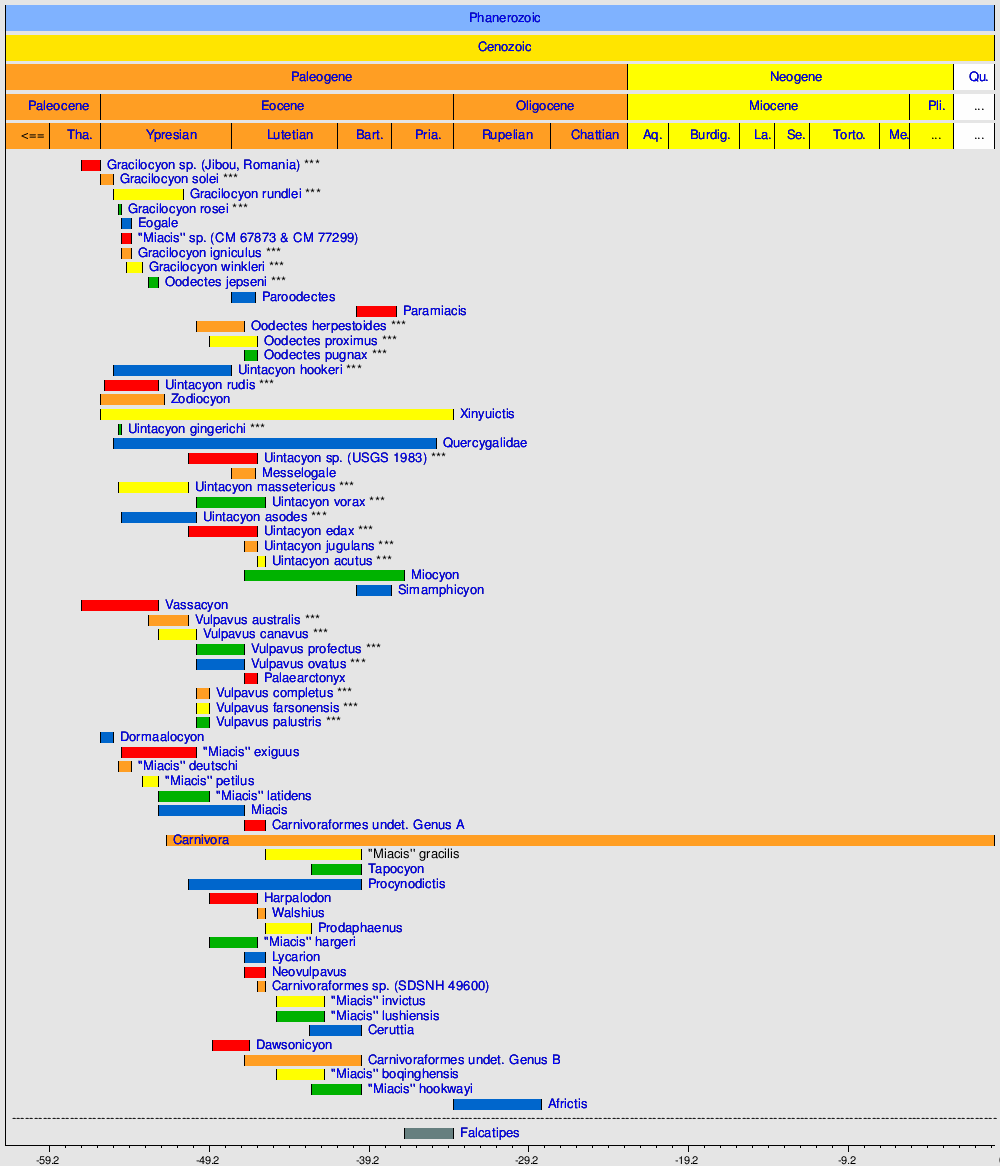Miacis gracilis
"Miacis" gracilis је изумрла врста плацентални сисара из кладуса Carnivoraformes, која је у периоду средњег еоцена настањивала подручје Сјеверне Америке.[2][3]
| "Miacis" gracilis Временски распон: средњи еоцен
| |
|---|---|
| Научна класификација | |
| Царство: | |
| Тип: | |
| Класа: | |
| (нерангирано): | |
| (нерангирано): | |
| (нерангирано): | |
| Род: | |
| Врста: | †"Miacis" gracilis Stock, 1934
|
| Синоними | |
| |
Етимологија назива
уреди| Врста: | Поријекло назива од: | Значење назива: |
|---|---|---|
| "M." gracilis | витки Мијакис |
Систематика
уредиИсторија класификације
уредиВрста "Miacis" gracilis је у почетку била уврштена унутар изумрлог рода Miacis. Касније је ова врста била класификована као дио полулације врсте Procynodictis vulpiceps, али се пак утврдило да се ради о засебној врсти сисара.[2][3] У каснијим истраживањима је ова врста препозната као засебан представник кладуса Carnivoraformes.[2][3] Међутим, у истраживању из 2016. године је ова врста била уврштена као примитивни представник псолике звијери,[4] али у истраживању из 2021. године је ова класификација оповргнута.[3]
Класификација
уреди| Врста: | Распрострањеност фосила и локација: |
Временски распон: |
|---|---|---|
| †"Miacis" gracilis (Clark, 1939)[5] | САД (Јута и Калифорнија) | 45,7 до 39,7 мил. год. |
Филогенија
уредиДоље приказан кладограм представља филогенетске везе врсте "Miacis" gracilis.[6][7][8][3]
| Carnivoramorpha |
|
†Gracilocyon/Oodectes група †Vulpavus група | |||||||||||||||||||||||||||||||||||||||||||||||||||||||||||||||||||||||||||||||||||||||||||||||||||||||||||||||||||||||||||||||||||||||||||||||||||||||||||||||||||||||||||||||||||||||||||||||||||||||||||||||||||||||||||||||||||||||||||||||||||||||||||||||||||||||||||||||||||||||||||||||||||||||||||||||||
| (Carnivora [sensu lato]) | |||||||||||||||||||||||||||||||||||||||||||||||||||||||||||||||||||||||||||||||||||||||||||||||||||||||||||||||||||||||||||||||||||||||||||||||||||||||||||||||||||||||||||||||||||||||||||||||||||||||||||||||||||||||||||||||||||||||||||||||||||||||||||||||||||||||||||||||||||||||||||||||||||||||||||||||||||
Временска распрострањеност врсте "Miacis" gracilis унутар кладуса Carnivoraformes
уреди
Види још
уредиРеференце
уреди- ^ L. Krishtalka and R. K. Stucky (1984) "Middle Eocene marsupials (Mammalia) from northeastern Utah and the mammalian fauna from Powder Wash." Annals of Carnegie Museum 53(2):31-46
- ^ а б в Tomiya, Susumu (2013). „New carnivoraforms (Mammalia) from the middle Eocene of California, USA, and comments on the taxonomic status of "Miacis" gracilis” (PDF). Palaeontologia Electronica. 16 (2): Article number 16.2.14A.
- ^ а б в г д Tomiya, S.; Zack, S. P.; Spaulding, M.; Flynn, J. J. (2021). „Carnivorous mammals from the middle Eocene Washakie Formation, Wyoming, USA, and their diversity trajectory in a post-warming world”. Journal of Paleontology. 95 (Supplement S82): 1—115. doi:10.1017/jpa.2020.74.
- ^ Tomiya, Susumu; Tseng, Zhijie Jack (2016). „Whence the beardogs? Reappraisal of the Middle to Late Eocene 'Miacis' from Texas, USA, and the origin of Amphicyonidae (Mammalia, Carnivora)”. Royal Society Open Science. 3 (10): 160518. Bibcode:2016RSOS....3p0518T. ISSN 2054-5703. PMC 5098994 . PMID 27853569. doi:10.1098/rsos.160518.
- ^ Clark, John (1939.) "Miacis gracilis, a new carnivore from the Uinta Eocene." Annals of The Carnegie Museum 27, 349-370
- ^ Flynn, John J.; Finarelli, John A.; Spaulding, Michelle (2010). „Phylogeny of the Carnivora and Carnivoramorpha, and the use of the fossil record to enhance understanding of evolutionary transformations”. Ур.: Goswami, Anjali; Friscia, Anthony. Carnivoran evolution. New views on phylogeny, form and function. Cambridge University Press. стр. 25–63. ISBN 9781139193436. doi:10.1017/CBO9781139193436.003.
- ^ Solé, Floréal; Smith, Richard; Coillot, Tiphaine; de Bast, Eric; Smith, Thierry (2014). „Dental and tarsal anatomy of Miacis latouri and a phylogenetic analysis of the earliest carnivoraforms (Mammalia, Carnivoramorpha)”. Journal of Vertebrate Paleontology. 34 (1): 1—21. ISSN 0272-4634. doi:10.1080/02724634.2013.793195.
- ^ Solé, Floréal; Smith, Thierry; De Bast, Eric; Codrea, Vlad; Gheerbrant, Emmanuel (2016). „New carnivoraforms from the latest Paleocene of Europe and their bearing on the origin and radiation of Carnivoraformes (Carnivoramorpha, Mammalia)”. Journal of Vertebrate Paleontology. 36 (2): e1082480. ISSN 0272-4634. doi:10.1080/02724634.2016.1082480.